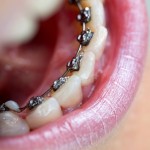
Demand for orthodontics because of increased interest in aesthetics. This trend is linked with invisible and tooth-coloured orthodontic appliances. Lingual orthodontic appliances also have aesthetic advantages over traditional buccal appliances although it is unclear which approach has fewer side effects.
The aim of this review was to assess whether lingual orthodontic techniques caused more adverse effects than buccal approaches.
Methods
Searches were conducted in the PubMed, EMBASE, Cochrane Library, and LILACS databases. There were no restrictions on language or publication date. Studies comparing lingual fixed appliances treatment with the buccal technique and those analysing adverse effects (pain, caries, eating difficulties, speech difficulties, and deficient oral hygiene) were considered. Two reviewers independently selected studies and assessed risk of bias of included studies. The Cochrane risk of bias tool was used for RCTs and the Newcastle-Ottawa Scale for non-randomised studies.
Results
- 8 studies ( 3 RCTs, 5 Controlled clinical trials [CCTs] ) were included
- The number of patients included in the studies ranged from 20 – 60
- Of the 3 RCTs 1 was considered to have low risk of bias, 1 moderate and 1 high.
- 4 of the 5 non-randomised studies were considered to be of high quality and 1 of low quality.
- Six studies (3 RCTs and 3 CCTs) were included in the meta-analysis, involving 131 patients who received buccal orthodontic treatment and 131 patients treated with lingual brackets.
- Patients who had lingual orthodontic treatment experienced significantly greater pain in the tongue, greater speech and eating difficulties, and problems in maintaining oral hygiene.
| Odds ratio (95%CI) | Probability | |
| Tongue pain | 28.32 (8.60-93.28) | P <0.001 |
| Cheek pain | 0.087 (0.036-0.213) | P <0.0010 |
| Lip pain | 0.13 (0.04-0.39) | P <0.001 |
| Speech difficulties | 9.39 (3.78-23.33) | P <0.001 |
| Oral hygiene problems | 3.49 (1.02-11.95) | P = 0.047 |
| Eating difficulties | 3.74 (0.86-16.28) | P = 0.079 |
| Caries | 1.15 (0.17-7.69) | P = 0.814 |
Conclusions
The authors concluded:-
To date, the little evidence we found suggests that lingual orthodontic techniques may induce higher levels of pain, speech difficulties, and oral hygiene problems. The results of our systematic review must be viewed with caution and suggest that further high-quality RCTs considering the differences between buccal and lingual appliances are needed to determine which orthodontic technique causes fewer adverse effects.
Comments
The authors have undertaken a methodologically sound review of this topic area. However only a small number of studies were available and only 3 of these were randomised controlled trials. In addition the studies were generally of small size. A recent review by Papageorgiou et al (Dental Elf – 21st Apr 2016) also highlighted that the available evidence for the effectiveness of lingual orthodontics was limited. The Papageorgiou review highlights the need for further evidence on the effectiveness of lingual orthodontics and it is important that when these studies are conducted appropriate detailing of any adverse effects is also undertaken
Links
Primary paper
Ata-Ali F, Ata-Ali J, Ferrer-Molina M, Cobo T, De Carlos F, Cobo J. Adverse effects of lingual and buccal orthodontic techniques: A systematic review and meta-analysis. Am J Orthod Dentofacial Orthop. 2016 Jun;149(6):820-9. doi: 10.1016/j.ajodo.2015.11.031. Review. PubMed PMID: 27241992.
Other references
Dental Elf – 21st Apr 2016
Lingual fixed orthodontic appliances: insufficient evidence of effectiveness

lingual orthodontic treatment has more adverse effects? https://t.co/XWhIJ843Rh
More adverse effects seen with lingual orthodontic appliances? https://t.co/XWhIJ8lFfR
Adverse effects of orthodontic treatment- greater with lingual approaches? https://t.co/XWhIJ8lFfR
Review suggests more adverse effects with lingual orthodontic appliances? https://t.co/XWhIJ8lFfR
Don’t miss – Lingual orthodontic treatment has more adverse effects?https://t.co/XWhIJ8lFfR